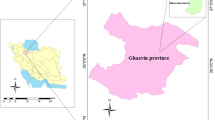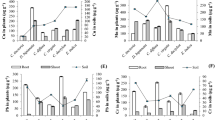Abstract
This study aimed to investigate the phytoremediation potential promoted by Baccharis dracunculifolia DC. and Baccharis trimera (Less.) DC. in copper mining tailing area, in the Southern part of Brazil. The plants were selected considering their spontaneous growth in tailing area. The phytoremediation indexes including translocation factor (TF), bioconcentration factor (BCF), metal extraction ratio (MER), and plant effective number (PEN) were assessed. Both species showed higher concentrations of heavy metals in the roots than to the shoots. B. trimera has potential for phytoextraction of Zn, Cd, Cr, and Pb and phytostabilization of Ba and Ni, whereas B. dracunculifolia demonstrated potential for phytoextraction of Pb and phytostabilization of Cu, Zn, and Ba. B. trimera showed higher potential in phytoremediation of the metals such as Cu > Zn > Cr > Ni and Cd than the B. dracunculifolia plants. A smaller number B. trimera plants was required to remove 1 g of Cu, Zn, Cr, Pb, Ni, and Cd than B. dracunculifolia plants, and implies that B. trimera is more efficient for decontamination of the metals. Both species showed potential for phytoremediation of metals in the mining tailing area under study.






Similar content being viewed by others
Data Availability
The datasets used and/or analyzed during the current study are available from the corresponding author on reasonable request.
References
ANM. (2020). Agência Nacional de Mineração. Anuário Mineral Brasileiro: Principais Substâncias Metálicas / Coord. Técnica de Marina Dalla Costa et al. ANM, Brasília, Brasília. Available from:https://www.gov.br/anm/ Accessed June 10, 2021.
MMA. (2020). The disruption of a mining tailings dam in Mariana and Brumadinho, in the Brazilian state of Minas Gerais. MMA, Brasília, Brasília. Available from: MMA.https://www.gov.br/mma/ June 10, 2021.
IBRAM. (2016). Gestão de Rejeitos de Mineração. IBRAM, Brasília, Brasília. Available from:https://ibram.org.br/wp-content/uploads/2021/02/Gestao-e-Manejo-de-Rejeitos-da-Mineracao-2016.pdf.
Sağlam, E. S., & Akçay, M. (2016). Chemical and mineralogical changes of waste and tailings from the Murgul Cu deposit (Artvin, NE Turkey): Implications for occurrence of acid mine drainage. Environmental Science and Pollution Research, 23(7), 6584–6607.
Mahmoud, R. H., &Hamza, A. H. M. (2017). In A.A. Ansari et al. (Eds.), Phytoremediation Management of Environmental Contaminants, vol. 3:Phytoremediation application: Plants as biosorbent for metal removal in soil and water (pp. 209–238). Springer International Publishing, Manhattan, NY.
Yoon, J., Cao, X., Zhou, Q., & Ma, L. Q. (2006). Accumulation of Pb, Cu, and Zn in native plants growing on a contaminated Florida site. Science of the Total Environment, 368, 456–464.
Zeng, P., Guo, Z., Cao, X., Xiao, X., Liu, Y., & Shi, L. (2018). Phytostabilization potential of ornamental plants grown in soil contaminated with cadmium. International Journal of Phytoremediation, 20, 311–320.
Lam, E. J., Gálvez, M. A., Cánovas, M., Montofré, I. L., & Keith, B. F. (2018). Assessment of the adaptive capacity of plant species in copper mine tailings in arid and semiarid environments. Journal of Soils and Sediments, 18, 2203–2216.
Boechat, L. C., Pistóia, V. C., Gianelo, C., & Camargo, F. A. O. (2016). Accumulation and translocation of heavy metal by spontaneous plants growing on multi-metal-contaminated site in the Southeast of Rio Grande do Sul state, Brazil. Environmental Science and Pollution Research, 23(3), 2371–2380.
Afonso, T. F., Demarco, C. F., Pieniz, S., Quadro, M. S.,& Camargo, F. A. O, Andreazza, R. (2020). Bioprospection of indigenous flora grown in copper mining tailing area for phytoremediation of metals. J Environ Manage, 256, 109953.
Barroso, G. M., Peixoto, A. L., Costa, C. G., Ichasso, C. L. F., Guimarães, E. F., & Lima, H. C. (1991). Systematics of angiosperms in Brazil. Imprensa Universitária.
Amaral, A. S., Mossi, A. J., Radünz, L. L., Treichel, H., Teixeira, A. J., Lerin, L. A., & Argenta, G. A. (2010). Crop of Baccharis trimera in nutrient solution with different concentrations of nitrogen, phosphorus and potassium. Perspectiva Erechim, 34, 25–34.
CONAMA, MMA. (2008). The basic parameters of the succession stages of the altitude fields associated with mixed tropical forest, dense tropical forest and semi-deciduous and deciduous seasonal forests in the Atlantic Forest biome. CONAMA, MMA, Brasília, Brasília:Availablefrom:http://www.ibama.gov.br/sophia/cnia/legislacao/MMA/RE0004-040594.PDF Accessed June 12, 2021.
Silva, R. M. G., Oliveira, V. M., Valadares, F., Mecina, G. F., &Silva, L. P. (2012). Genotoxic activity and toxicity of Baccharis trimera Less. regarding the bioaccumulation of heavy metals. J Med Plants Res, 6(26), 4321- 4327.
IBGE. 2012. Manual Técnico de Vegetação Brasileira. IBGE, Rio de Janeiro, RJ.
Brasil. (2006). National water resources plan., National programs and targets. MMA, Brasília, Brasília.
EMBRAPA. (2013). Braziliansoilclassification system. EMBRAPA, Brasília, Brasília.
Teixeira, G., Gonzalez, A. P., Gonzalez, M. A., & Licht, O. A. B. (1978). Contribution to the study of disseminated cuprifferousmineralizations in the Minas do Camaquã district. Brazilian Congress of Geology, 4, 1644–1654.
Hunter, A. H. (1975). Laboratory analysis of vegetal tissues samples. North Carolina University.
Tedesco, M. J., Gianello, C., Bissani, C. A., Bohnen, H., &Volkweiss, S. J. (1995). Analysis of soil, plants and other materials. UFRGS, Soil Department, Porto Alegre, RS.
Landon, J. R. (1991). Booker tropical soil manual. Longman Scientific and Technical,New York, NY.
USEPA. (1998). Method 3050B Acid digestion of sediments, sludges, and soils. United States Environmental Protection Agency. Available from:https://www.epa.gov/sites/production/files/2015-06/documents/epa-3050b.pdf Accessed Dec 09, 2021.
FEPAM. (2014). Portaria nº 5, dispõe sobre o estabelecimento de valores de referência de qualidade (VRQ) dos solos para 09 (nove) elementos químicos naturalmente presentes nas diferentes províncias geomorfológicas/geológicas do Estado do Rio Grande do Sul. FEPAM, Porto Alegre, RS. Availablefrom: http://www.fepam.rs.gov.br/legislacao/arq/Portaria085-2014.pdf Accessed June 12, 2021.
CONAMA. (2013). Resolution nº 460, provides criteria and values guiding soil quality as to the presence of chemical substances. CONAMA, Brasília, Brasília. Available from: https://www.ibama.gov.br/component/legislacao/?view=legislacao&legislacao=131499 Accessed June 12, 2021.
Cai, Y., &Ma, L. Q. (2003). In Cai Y, Braids O, (Eds.), Biogeochemistry of Environmentally Important Trace:Metal tolerance, accumulation, and detoxification in plants with emphasis on arsenic in terrestrial plants (pp. 95–114). AAmerican Chemical Society, Washington, DC.
EMBRAPA. (2010). Soil fertility and management concepts suitable for climatic regions. EMBRAPA, Campinas, SP. Availablefrom:https://ainfo.cnptia.embrapa.br/digital/bitstream/item/219305/1/5840.pdf Accessed June 12, 2021.
SBCS-NRS. (2016). Manual de Adubação e Calagem RS e SC. Comissão de Química e Fertilidade do Solo - RS/SC, Porto Alegre, RS. Availablefrom:http://www.sbcs-nrs.org.br/docs/Manual_de_Calagem_e_Adubacao_para_os_Estados_do_RS_e_de_SC-2016.pdf Accessed June 12, 2021.
Rezvani, M., & Zaefarian, F. (2011). Bioaccumulation and translocation factors of cadmium and lead in Aeluropus littoralis. Aust J Agric Eng, 2(4), 114.
Jamil, S., Abhilash, P. C., Singh, N., & Sharma, P. N. (2009). Jatropha curcas: A potential crop for phytoremediation of coal fly ash. Journal of Hazardous Materials, 172, 269–275.
Kamari, A., Yusoff, S. N. M., Putra, W. P., Hashim, N., Mohamed, A., & Phillip, E. (2014). Metal uptake in water spinach grow on contaminated soil amended with chicken manure and coconut tree sawdust. Environmental Engineering and Management Journal, 13(9), 2219–2228.
Mertens, J., Luyssaert, S., & Verheyen, K. (2005). Use and abuse of trace metal concentrations in plant tissue for biomonitoring and phytoextraction. Environmental Pollution, 138(1), 1–4.
García, G., Faz, Á., & Cunna, M. (2004). Performance of Piptatherum miliaceum (Smilo grass) in edaphic Pb and Zn phytoremediation over a short growth period Int. Biodeterior Biodegrad, 54, 245–250.
Santos, R. F., Lima, L., Altivo, F. S., Lalla, J. G., & Ming, L. C. (2011). Phytomass production, content, and productivity of essential oil of Baccharis dracunculifolia DC. as affected by organic compound. Revista Brasileira de Medicina, 13, 574–581.
Melo-Júnior, J. C. F., Amorim, M. W., Severino, A. L., Oliveira, T. M. N., & Barros, V. G. (2015). Diversity and community structure of vegetation in natural regeneration in an area of dump off. Acta Biol Catarinense, 2, 32–47.
Prasad, M. N. V. (2015). Geobotany-biogeochemical prospecting. The Paleobotanist, 64(2015), 113–116.
Wei, S. H., Zhou, Q. X., & Wang, X. (2005). Identification of weed plants excluding the absorption of heavy metals. Environmental International, 31(6), 829–834.
Reeves, R. D., &Baker, A. J. M. (2000). In Raskin I, Ensley B. D, (Eds.), Metal accumulating plants: Phytoremediation of toxic metals: using plants to clean up the environment (pp. 151–170). John Wileyand Sons, New York, NY.
Gilberti, L., Menezes, A., Rodrigues, A. C., Fernades, G. W., Berbara, R. L. L., & Marota, H. B. (2014). Effects of arsenic on the growth, uptake and distribution of nutrients in the tropical species Baccharis dracunculifolia DC (asteraceae). European Journal of Toxicology Science, 2014, 1–27.
Shen, Z., Wang, Y., Chen, Y., & Zhang, Z. (2017). Transfer of heavy metals from the polluted rhizosphere soil to Celosia argentea L. in copper mine tailings. Horticulture, Environment and Biotechnology, 58, 93–100.
Zhao, F. J., Hamon, R. E., Lombi, E., McLaughlin, M. J., & McGrath, S. P. (2002). Characteristics of cadmium uptake in two contrasting ecotypes of the hyperaccumulator thlaspicaerulescens. Journal of Experimental Botany, 53(368), 535–543.
Kabata-Pendias, A. (2010). Trace elements in soils and plants. CRC Pres.
Silva, P. S. C., Francisconi, L. S., & Gonçalves, R. D. M. R. (2016). Evaluation of major and trace elements in medicinal plants. Journal of the Brazilian Chemical Society, 27(12), 2273–2289.
León-Romero, M. A., Soto-Ríos, P. S., Nomura, M., & Nishimura, O. (2018). Effect of steel slag to improve soil quality of tsunami-impacted land while reducing the risk of heavy metal bioaccumulation. Water Air SoilPollut, 229, 12.
Boechat, C. L., Quadros, P. D. D., Giovanella, P., Brito, A. C. C., Carlos, F. S. C., Sá, E. L. S. D., & Camargo, F. A. D. O. (2018). Metal-resistantrhizobacteriachangesoluble-exchangeablefraction in multi-metal-contaminatedsoil samples. Revista Brasileira de Ciência do Solo, 42, 1–10.
Menezes, A. P. S., Silva, J. D., Roloff, J., Reyes, J., Debastiani, R., Dias, J. F., Rohf, P.,& Ferraz, A. D. B. F. (2013).Baccharis trimera (Less.) DC as genotoxicity indicator of exposure to coal and emissions from a thermal power plant.Arch Environ Contam Toxicol,65, 434–441.
Kavousi, H. R., Karimi, M. R., & Neghab, M. G. (2021). Assessment the copper-induced changes in antioxidant defense mechanisms and copper phytoremediation potential of common mullein (Verbascum thapsus L.). Environmental Science and Pollution Research, 28, 18070–18080.
Meng, C., Song, N. P., Yue, J. M., Xie, L., Zhong, Y. X., & Du, L. T. (2021). Screening of hyperaccumulator plants tolerant to drought and salinity and its medicinal value evaluation for ecological reconstruction of copper silver tailings in Northwest China. Pollution, 7(1), 87–100.
Andreazza, R., Bortolon, L., Pieniz, S., Bento, F. M., & Camargo, F. A. O. (2015). Evaluation of two brazilian indigenous plants for phytostabilization and phytoremediation of copper-contaminated soils. Brazilian Journal of Biology, 75, 868–877.
Funding
This study was financed in part by the Coordenação de Aperfeiçoamento de Pessoal de Nível Superior – Brasil (CAPES) – Finance code 001, by the CNPq (National Council for Scientific and Technological Development) and FAPERGS (Research Support Foundation of the State of Rio Grande do Sul).
Author information
Authors and Affiliations
Contributions
TFA and RA conceptualized the study. TFA performed the main experimental work, evaluated the dataset, and wrote the main text of the manuscript. TFA and FAOC performed the analyses. SP, MSQ, and CFD were involved in proofreading of the manuscript.
Corresponding author
Ethics declarations
Ethics Approval and Consent to Participate
Not applicable. The manuscript does not contain data collected from humans or animals.
Consent for Publication
Not applicable. The manuscript does not contain any individual person’s data.
Competing Interests
The authors declare no competing interests.
Additional information
Publisher's Note
Springer Nature remains neutral with regard to jurisdictional claims in published maps and institutional affiliations.
Rights and permissions
About this article
Cite this article
Afonso, T.F., Demarco, C.F., Pieniz, S. et al. Analysis of Baccharis dracunculifolia and Baccharis trimera for Phytoremediation of Heavy Metals in Copper Mining Tailings Area in Southern Brazil. Appl Biochem Biotechnol 194, 694–708 (2022). https://doi.org/10.1007/s12010-021-03652-3
Received:
Accepted:
Published:
Issue Date:
DOI: https://doi.org/10.1007/s12010-021-03652-3




